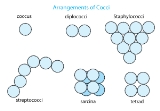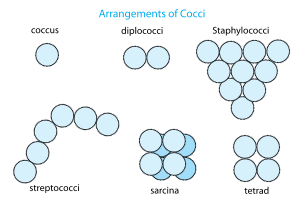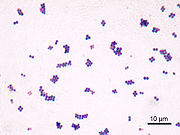
Coccus
Encyclopedia


Bacillus (shape)
The word bacillus may be used to describe any rod-shaped bacterium, and such bacilli are found in many different taxonomic groups of bacteria. However, the name Bacillus, capitalized and italicized, refers to a specific genus of bacteria...
(rod-shaped) and spirillum
Spirillum
Spirillum in microbiology refers to a bacterium with a cell body that twists like a spiral. It is the third distinct bacterial cell shape type besides coccus and bacillus cells.-Taxonomic:...
(spiral-shaped) cells. Coccus is an English loanword
Loanword
A loanword is a word borrowed from a donor language and incorporated into a recipient language. By contrast, a calque or loan translation is a related concept where the meaning or idiom is borrowed rather than the lexical item itself. The word loanword is itself a calque of the German Lehnwort,...
of a Neolatin noun, which in turn stems from the Greek masculine noun kokkos (κόκκος) meaning "berry".
The term 'coccus' is used in botany to denote a mericarp or 1-seeded segment of a schizocarp
Schizocarp
A schizocarp is a dry fruit that develops from multiple carpels. When mature it splits up into mericarps. Mericarps are often 1-seeded as in, for example, Malva, Malvastrum, and Sida...
.
Arrangement
Like all bacteria, each single coccus bacterium is an entire living organism. However, some species exist in groups of cells. If they do group together , the patterns they arrange themselves in are given certain names based on the shape. DiplococciDiplococcus
A diplococcus is a round bacterium that typically occurs in the form of two joined cells. Examples are Streptococcus pneumoniae, Moraxella catarrhalis, Neisseria gonorrhoeae and Neisseria meningitidis...
are arranged in two-cell pairs; these may represent several different genera
Genus
In biology, a genus is a low-level taxonomic rank used in the biological classification of living and fossil organisms, which is an example of definition by genus and differentia...
. Bacteria in the Streptococcus
Streptococcus
Streptococcus is a genus of spherical Gram-positive bacteria belonging to the phylum Firmicutes and the lactic acid bacteria group. Cellular division occurs along a single axis in these bacteria, and thus they grow in chains or pairs, hence the name — from Greek στρεπτος streptos, meaning...
genus are arranged in chains. Bacteria in the Sarcina
Sarcina (genus)
Sarcina is a genus of Gram-positive cocci bacteria in the family Clostridiaceae. A synthesizer of microbial cellulose, they have a cuboidal cell arrangement...
genus typically form a cuboidal arrangement of eight cells. Staphylococcus
Staphylococcus
Staphylococcus is a genus of Gram-positive bacteria. Under the microscope they appear round , and form in grape-like clusters....
is a genus of bacteria characterized by cells arranged in tetrad clusters (four cells in a square formation) or large, often irregular, clusters. While groups of cells together form these characteristic shapes, the individual bacterial cells themselves will appear as distinct circles within the chain or cluster.

